43.5: Mimba ya Binadamu na Kuzaliwa
- Page ID
- 175872
Ujuzi wa Kuendeleza
- Eleza maendeleo ya fetusi wakati wa trimesters tatu za ujauzito
- Eleza kazi na utoaji
- Linganisha ufanisi na muda wa aina mbalimbali za uzazi wa mpango
- Jadili sababu za kutokuwepo na chaguzi za matibabu zinazopatikana
Mimba huanza na mbolea ya yai na inaendelea hadi kuzaliwa kwa mtu binafsi. Urefu wa muda wa ujauzito hutofautiana kati ya wanyama, lakini ni sawa sana kati ya nyani wakuu: ujauzito wa binadamu ni siku 266, ilhali mimba ya sokwe ni siku 237, gorilla ni siku 257, na mimba ya orangutan ni muda wa siku 260. Mbweha ina ujauzito wa siku 57. Mbwa na paka zina ujauzito sawa na wastani wa siku 60. Uzazi mrefu zaidi kwa mamalia wa ardhi ni tembo wa Afrika katika siku 640. Uzazi mrefu zaidi kati ya mamalia wa baharini ni nyangumi wa beluga na mbegu za kiume katika siku 460.
Ujaaji wa binadamu
Masaa ishirini na nne kabla ya mbolea, yai imemaliza meiosis na inakuwa oocyte kukomaa. Wakati wa mbolea (wakati wa mimba) yai hujulikana kama zygote. Zygote husafiri kupitia oviduct kwenye uterasi (Kielelezo\(\PageIndex{1}\)). Kiinitete kinachoendelea kinapaswa kuingiza ndani ya ukuta wa uterasi ndani ya siku saba, au kitaharibika na kufa. Tabaka za nje za zygote (blastocyst) hukua ndani ya endometriamu kwa kuchimba seli za endometriamu, na uponyaji wa jeraha wa endometriamu hufunga blastocyst ndani ya tishu. Safu nyingine ya blastocyst, chorion, huanza kutoa homoni inayoitwa binadamu beta chorionic gonadotropini (β -HCG) ambayo inafanya njia yake kwenda corpus luteum na inaweka muundo huo kazi. Hii inahakikisha viwango vya kutosha vya progesterone ambayo itahifadhi endometriamu ya uterasi kwa msaada wa kiinitete kinachoendelea. Vipimo vya ujauzito huamua kiwango cha β -HCG katika mkojo au seramu. Ikiwa homoni iko, mtihani ni chanya.
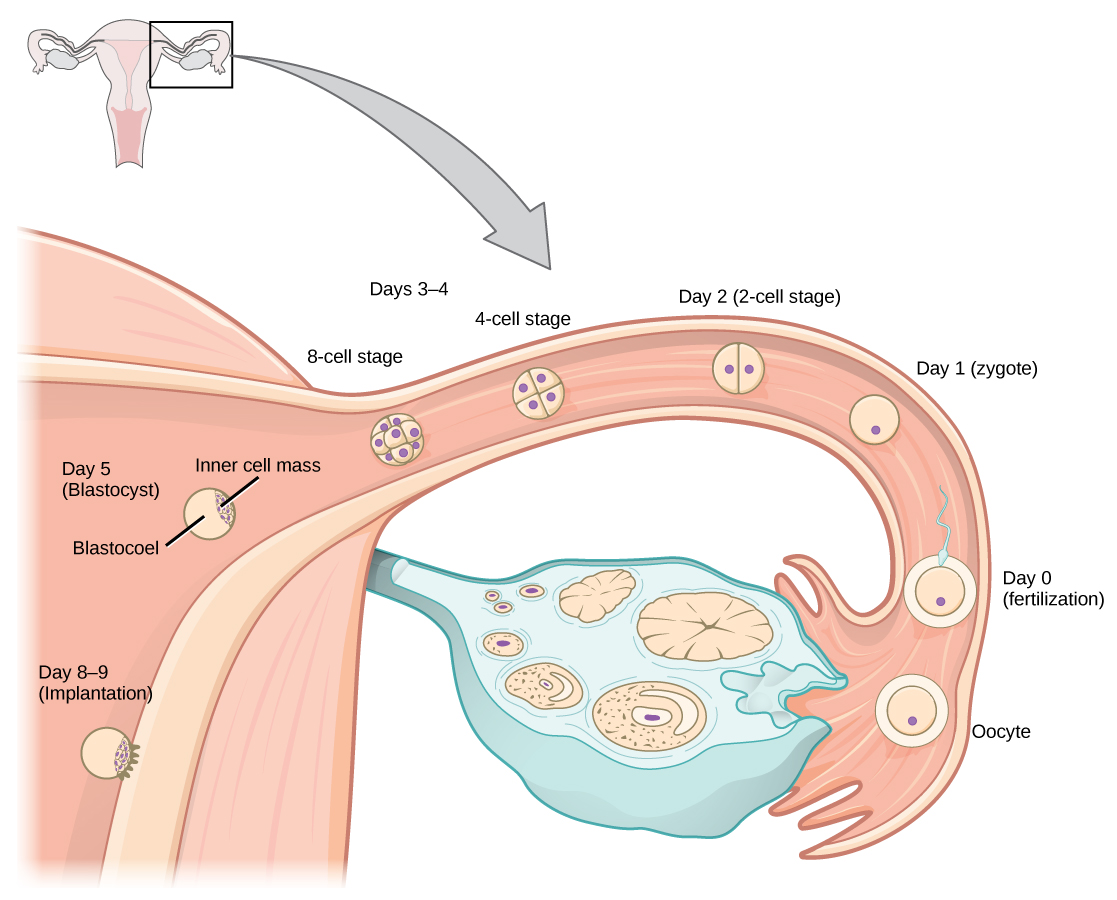
Kipindi cha ujauzito kinagawanywa katika vipindi vitatu sawa au trimesters. Wakati wa wiki mbili hadi nne za trimester ya kwanza, lishe na taka vinashughulikiwa na kitambaa cha endometrial kwa njia ya kutenganishwa. Kama trimester inavyoendelea, safu ya nje ya kiinitete huanza kuunganisha na endometriamu, na fomu za placenta. Kiungo hiki kinachukua mahitaji ya virutubisho na taka ya kiinitete na fetusi, na damu ya mama inapitisha virutubisho kwenye placenta na kuondoa taka kutoka kwao. Kemikali kutoka kwa fetusi, kama vile bilirubin, hutumiwa na ini ya mama ili kuondoa. Baadhi ya immunoglobulins ya mama watapita kupitia placenta, kutoa kinga ya kinga dhidi ya maambukizi mengine.
Viungo vya ndani na miundo ya mwili huanza kuendeleza wakati wa trimester ya kwanza. Kwa wiki tano, buds za miguu, macho, moyo, na ini zimeundwa kimsingi. Kwa wiki nane, neno la fetusi linatumika, na mwili hutengenezwa kimsingi, kama inavyoonekana kwenye Kielelezo\(\PageIndex{2}\). Mtu binafsi ni takriban sentimita tano (inchi mbili) kwa urefu na viungo vingi, kama vile mapafu na ini, bado havifanyi kazi. Mfiduo wa sumu yoyote ni hatari sana wakati wa trimester ya kwanza, kama viungo vyote vya mwili na miundo hupitia maendeleo ya awali. Kitu chochote kinachoathiri maendeleo hayo kinaweza kuwa na athari kubwa juu ya maisha ya fetusi.
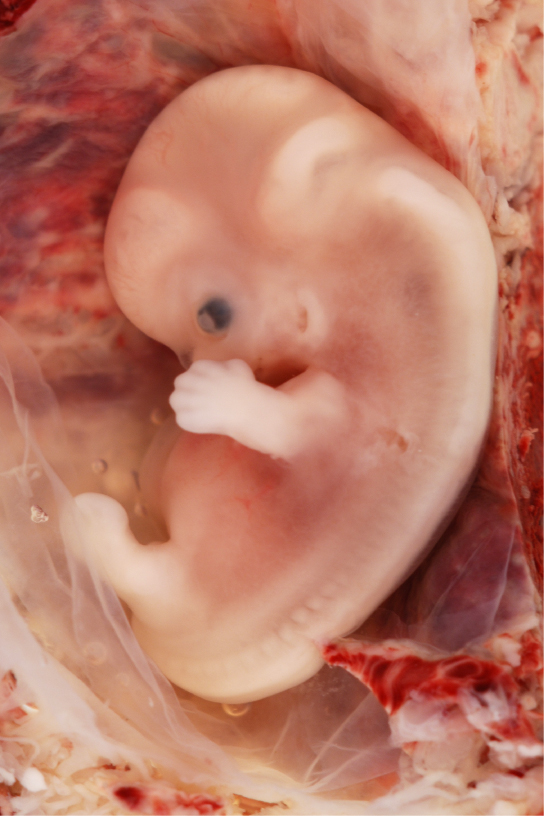
Wakati wa trimester ya pili, fetusi inakua hadi cm 30 (inchi 12), kama inavyoonekana kwenye Mchoro\(\PageIndex{3}\). Inakuwa hai na mama huhisi harakati za kwanza. Viungo vyote na miundo huendelea kuendeleza. Placenta imechukua kazi za lishe na taka na uzalishaji wa estrogen na progesterone kutoka kwa luteum ya corpus, ambayo imeharibika. Placenta itaendelea kufanya kazi kupitia utoaji wa mtoto.
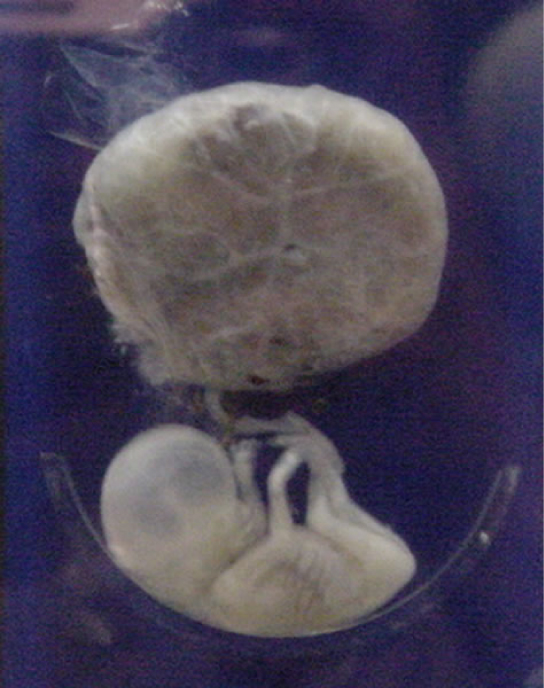
Wakati wa trimester ya tatu, fetusi inakua hadi kilo 3 hadi 4 (6 ½ -8 ½ lbs.) na juu ya cm 50 (19-20 inches) kwa muda mrefu, kama ilivyoonyeshwa kwenye Kielelezo\(\PageIndex{4}\). Hii ni kipindi cha ukuaji wa haraka zaidi wakati wa ujauzito. Maendeleo ya chombo yanaendelea kuzaliwa (na mifumo mingine, kama mfumo wa neva na ini, inaendelea kuendeleza baada ya kuzaliwa). Mama atakuwa na wasiwasi zaidi wakati wa trimester hii. Anaweza kukimbia mara kwa mara kutokana na shinikizo kwenye kibofu cha kibofu kutoka kwenye fetusi. Kunaweza pia kuwa na uzuiaji wa tumbo na matatizo ya mzunguko, hasa katika miguu yake. Vipande vinaweza kuunda miguu yake kutokana na shinikizo kutoka kwa fetusi juu ya kurudi mishipa wakati wanaingia kwenye cavity ya tumbo.
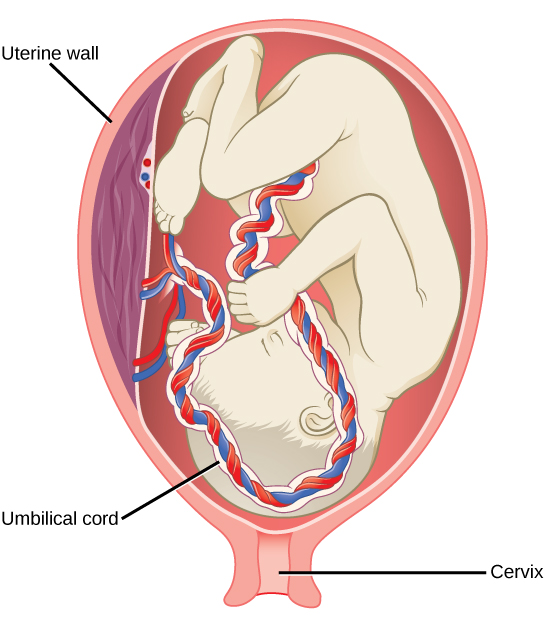
Kazi na Kuzaliwa
Kazi ni jitihada za kimwili za kufukuzwa kwa fetusi na placenta kutoka kwa uzazi wakati wa kuzaliwa (kujifungua). Kuelekea mwisho wa trimester ya tatu, estrogen husababisha receptors kwenye ukuta wa uterini kuendeleza na kumfunga homoni oxytocin. Kwa wakati huu, mtoto anarudi, inakabiliwa mbele na chini na nyuma au taji ya kichwa inayohusisha kizazi cha uzazi (ufunguzi wa uterini). Hii inasababisha kizazi cha uzazi kunyoosha na msukumo wa neva hupelekwa hypothalamus, ambayo inaashiria kutolewa kwa oxytocin kutoka kwenye pituitary ya posterior. Oxytocin husababisha misuli ya laini katika ukuta wa uterini kwa mkataba. Wakati huo huo, placenta hutoa prostaglandini ndani ya uterasi, na kuongeza vipindi. Maoni mazuri ya relay hutokea kati ya uterasi, hypothalamus, na pituitary ya posterior ili kuhakikisha ugavi wa kutosha wa oxytocin. Kama seli zaidi za misuli ya laini zinaajiriwa, vipindi vinaongezeka kwa nguvu na nguvu.
Kuna hatua tatu za kufanya kazi. Wakati wa hatua moja, kizazi cha uzazi hupungua na hupunguza. Hii ni muhimu kwa mtoto na placenta kufukuzwa wakati wa kuzaliwa. Mimba ya kizazi hatimaye itapanua hadi cm 10. Wakati wa hatua mbili, mtoto hufukuzwa kutoka kwenye uterasi. Mikataba ya uterasi na mama hupiga kama anapunguza misuli yake ya tumbo ili kusaidia utoaji. Hatua ya mwisho ni kifungu cha placenta baada ya mtoto kuzaliwa na chombo kimetengana kabisa na ukuta wa uterini. Ikiwa kazi inapaswa kuacha kabla ya hatua mbili kufikiwa, oxytocin ya synthetic, inayojulikana kama Pitocin, inaweza kusimamiwa kuanzisha upya na kudumisha kazi.
Njia mbadala ya kazi na utoaji ni utoaji wa upasuaji wa mtoto kupitia utaratibu unaoitwa sehemu ya Kaisari. Hii ni upasuaji mkubwa wa tumbo na inaweza kusababisha matatizo baada ya upasuaji kwa mama, lakini wakati mwingine inaweza kuwa njia pekee ya kumtoa mtoto kwa usalama.
Vidonda vya mammary vya mama hupitia mabadiliko wakati wa trimester ya tatu ili kujiandaa kwa lactation na kunyonyesha. Wakati mtoto anaanza kunyonya kwenye kifua, ishara zinatumwa kwa hypothalamus na kusababisha kutolewa kwa prolactini kutoka pituitary ya anterior. Prolactini husababisha tezi za mammary kuzalisha maziwa. Oxytocin pia hutolewa, kukuza kutolewa kwa maziwa. Maziwa yana virutubisho kwa ajili ya maendeleo na ukuaji wa mtoto pamoja na immunoglobulins kulinda mtoto kutokana na maambukizi ya bakteria na virusi.
Uzazi wa mpango na Uzazi
Kuzuia mimba huja chini ya masharti ya uzazi wa mpango au udhibiti wa uzazi. Kwa kusema, uzazi wa mpango unamaanisha kuzuia mbegu na yai kutoka kujiunga. Maneno yote mawili, hata hivyo, hutumiwa mara kwa mara kwa kubadilishana.
Jedwali\(\PageIndex{1}\): Mbinu za Uzazi
| Mbinu | Mifano | Kiwango cha Kushindwa katika Matumizi ya kawaida Zaidi ya Miezi 12 |
|---|---|---|
| Kikwazo | kondomu ya kiume, kondomu ya kike, sifongo, cap ya kizazi, diaphragm, sp | 15 hadi 24% |
| Homoni | mdomo, kiraka, pete ya uke | 8% |
| sindano | 3% | |
| kuingiza | chini ya 1% | |
| Nyingine | uzazi wa asili | 12 hadi 25% |
| kujiondoa | 27% | |
| kufunga uzazi | chini ya 1% |
Jedwali\(\PageIndex{1}\) lists common methods of contraception. The failure rates listed are not the ideal rates that could be realized, but the typical rates that occur. A failure rate is the number of pregnancies resulting from the method’s use over a twelve-month period. Barrier methods, such as condoms, cervical caps, and diaphragms, block sperm from entering the uterus, preventing fertilization. Spermicides are chemicals that are placed in the vagina that kill sperm. Sponges, which are saturated with spermicides, are placed in the vagina at the cervical opening. Combinations of spermicidal chemicals and barrier methods achieve lower failure rates than do the methods when used separately.
Nearly a quarter of the couples using barrier methods, natural family planning, or withdrawal can expect a failure of the method. Natural family planning is based on the monitoring of the menstrual cycle and having intercourse only during times when the egg is not available. A woman’s body temperature may rise a degree Celsius at ovulation and the cervical mucus may increase in volume and become more pliable. These changes give a general indication of when intercourse is more or less likely to result in fertilization. Withdrawal involves the removal of the penis from the vagina during intercourse, before ejaculation occurs. This is a risky method with a high failure rate due to the possible presence of sperm in the bulbourethral gland’s secretion, which may enter the vagina prior to removing the penis.
Hormonal methods use synthetic progesterone (sometimes in combination with estrogen), to inhibit the hypothalamus from releasing FSH or LH, and thus prevent an egg from being available for fertilization. The method of administering the hormone affects failure rate. The most reliable method, with a failure rate of less than 1 percent, is the implantation of the hormone under the skin. The same rate can be achieved through the sterilization procedures of vasectomy in the man or of tubal ligation in the woman, or by using an intrauterine device (IUD). IUDs are inserted into the uterus and establish an inflammatory condition that prevents fertilized eggs from implanting into the uterine wall.
Compliance with the contraceptive method is a strong contributor to the success or failure rate of any particular method. The only method that is completely effective at preventing conception is abstinence. The choice of contraceptive method depends on the goals of the woman or couple. Tubal ligation and vasectomy are considered permanent prevention, while other methods are reversible and provide short-term contraception.
Termination of an existing pregnancy can be spontaneous or voluntary. Spontaneous termination is a miscarriage and usually occurs very early in the pregnancy, usually within the first few weeks. This occurs when the fetus cannot develop properly and the gestation is naturally terminated. Voluntary termination of a pregnancy is an abortion. Laws regulating abortion vary between states and tend to view fetal viability as the criteria for allowing or preventing the procedure.
Infertility
Infertility is the inability to conceive a child or carry a child to birth. About 75 percent of causes of infertility can be identified; these include diseases, such as sexually transmitted diseases that can cause scarring of the reproductive tubes in either men or women, or developmental problems frequently related to abnormal hormone levels in one of the individuals. Inadequate nutrition, especially starvation, can delay menstruation. Stress can also lead to infertility. Short-term stress can affect hormone levels, while long-term stress can delay puberty and cause less frequent menstrual cycles. Other factors that affect fertility include toxins (such as cadmium), tobacco smoking, marijuana use, gonadal injuries, and aging.
If infertility is identified, several assisted reproductive technologies (ART) are available to aid conception. A common type of ART is in vitro fertilization (IVF) where an egg and sperm are combined outside the body and then placed in the uterus. Eggs are obtained from the woman after extensive hormonal treatments that prepare mature eggs for fertilization and prepare the uterus for implantation of the fertilized egg. Sperm are obtained from the man and they are combined with the eggs and supported through several cell divisions to ensure viability of the zygotes. When the embryos have reached the eight-cell stage, one or more is implanted into the woman’s uterus. If fertilization is not accomplished by simple IVF, a procedure that injects the sperm into an egg can be used. This is called intracytoplasmic sperm injection (ICSI) and is shown in Figure \(\PageIndex{5}\). IVF procedures produce a surplus of fertilized eggs and embryos that can be frozen and stored for future use. The procedures can also result in multiple births.
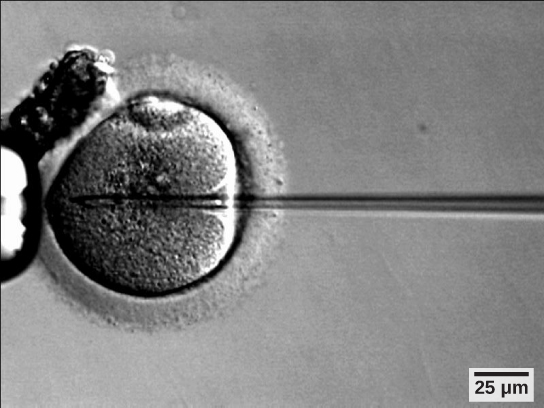
Summary
Human pregnancy begins with fertilization of an egg and proceeds through the three trimesters of gestation. The labor process has three stages (contractions, delivery of the fetus, expulsion of the placenta), each propelled by hormones. The first trimester lays down the basic structures of the body, including the limb buds, heart, eyes, and the liver. The second trimester continues the development of all of the organs and systems. The third trimester exhibits the greatest growth of the fetus and culminates in labor and delivery. Prevention of a pregnancy can be accomplished through a variety of methods including barriers, hormones, or other means. Assisted reproductive technologies may help individuals who have infertility problems.
Glossary
- contraception
- (also, birth control) various means used to prevent pregnancy
- gestation
- length of time for fetal development to birth
- human beta chorionic gonadotropin (β-HCG)
- hormone produced by the chorion of the zygote that helps to maintain the corpus luteum and elevated levels of progesterone
- infertility
- inability to conceive, carry, and deliver children
- morning sickness
- condition in the mother during the first trimester; includes feelings of nausea
- placenta
- organ that supports the diffusion of nutrients and waste between the mother’s and fetus’ blood



